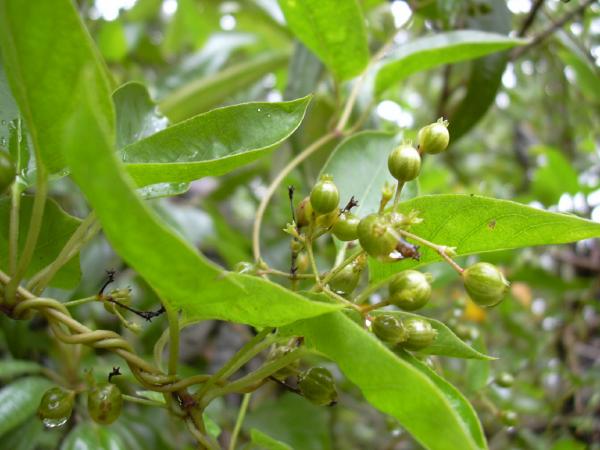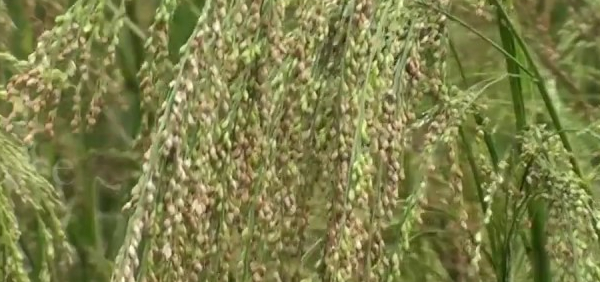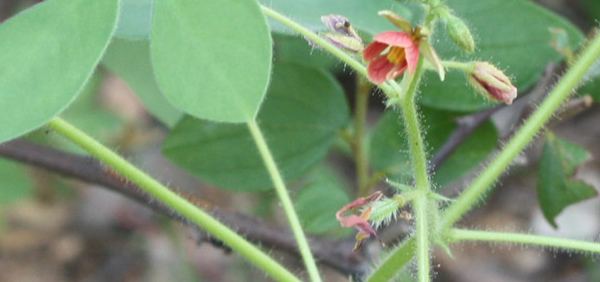gandhaprasarini :

Morphology:
Root – Tap root 2-4 cm long, 0.5-2 cm thick, cylindrical or sub cylindrical, tortuous, having a number of branches and rootlets; dark brown; surface rough due to longitudinal wrinkles, ridges and fissures; remnants of rootlet, thin scars and numerous horizontal lenticels also present; fracture, short in bark region and somewhat fibrous in wood; odour, disagreeable and foetid more marked in fresh samples; taste, indistinct.
Stem – Slender, sub-erect with diffuse branching, upto 4 cm thick; subcylindrical showing a dumb-bell shaped appearance in transverse view due to presence of two prominant furrows running opposite each other on both surfaces, externally dark brown, longitudinal anastomosing wrinkles, ridges and a few transverse cracks and circular lenticels, fracture, fibrous; odour, foetid more marked in fresh samples; taste, indistinct.
Leaf – Simple, petiolate, stipulate; 10-15 cm long, 5-6 cm broad; somewhat glabrous; ovate, entire, base narrow or broad, apex acute or cuspidate; stipule ovate, lanceolate, bifid, entire, acute, base broad with hairy surface, texture, thin; odour, foetid more distinct in fresh samples; taste, indistinct.
Flower – Violet to pink; bracteate, pedicellate, bisexual, calyx campanulate, acutely, toothed; corolla funnel-shaped, usually pubescent, somewhat gibbous and wooly inside, limb narrow, divided into five cordate crenulate segments, lobes short; filament short, inserted irregularly about the middle of the tube, anther erect within the tube; ovary turbinate, two celled containing one ovule, each attached to the bottom of the cell; style, simple; stigma two cleft with lobes bent amongst the anther.
Fruit – Berry, orbicular, ellipsoid, compressed, smooth with five lines on each side, one celled, two seeded, 1.1 cm across, red or black.
Seed – Compressed, smooth, enlarged with somewhat membranous ring all round.
Histology:
Root – Mature root shows 6-13 layers of cork, composed of tangentially elongated cells, in outer few layers somewhat collapsed, lignified and filled with brown content; cork cambium 1-2 layers; secondary cortex 5-16 layers of thin-walled; somewhat radially arranged parenchymatous cells; secondary phloem appears as wedge-shaped conical masses consisting of sieve elements and parenchyma traversed by phloem rays; major portion of phloem element thick-walled, sieve elements form collapsed masses of ceratenchyma in outer region and intact in inner most region; uni to biseriate phloem rays composed of usually thick-walled cells in outer and middle phloem region; multiseriate phloem rays composed of thin-walled parenchymatous cells showing funnel-shaped dilatation in outer phloem region; in tangential section through inner phloem region sieve cells shows beaded thickening; cambium 1-3 layered; secondary xylem consists of wide zope of lignified and non-lignified tissue traversed by xylem rays; lignified tissue consists of vessels, tracheids and fibres; non-lignified tissue consists of thin-walled parenchymatous cells; xylem vessels distributed singly or in groups of two to three having variable shape and bordered pits; tracheids long and narrow having bordered pits; fibres long, narrow having simple pits; xylem parenchyma have simple pits or reticulate thickening; xylem ray cells thin-walled, circular to somewhat radially elongated in non-lignified zone and thick-walled, lignified and radially elongated in lignified zone having simple pits; starch grains as granular masses,
oil globules as small circular bodies and raphides of calcium oxalate present in a few cells of secondary cortex, phloem, xylem and medullary rays.
Stem – Mature stem shows 7-11 layers of cork composed of rectangular cells, a few outer layers lignified; secondary cortex 6-9 layers consisting of thin-walled parenchymatous cells; pericyclic fibres present in singles or in groups of two to three, much elongated and septate with very narrow lumen; secondary phloem much similar to that of root having thick-walled phloem elements, arranged in wedged-shaped conical masses, with ceratenchyma, two types of phloem rays, sieve cells with beaded thickening; cambium 1-2 layers; secondary xylem represented by lignified and nonlignified tissues; inner most xylem composed of thin compact band of 8-9 layers of lignified tissue with primary xylem attached towards pits, xylem vessels associated with tracheids, fibres and lignified or non-lignified parenchyma; a few xylem vessels show tyloses; all elements have similar pittings as described in case of root; uni and biseriate rays thin-walled but lignified; in lignified region, multiseriate rays usually thin-walled; centre of stem occupied by small pith and a few sclereids; a few cells of secondary cortex, phloem, xylem, medullary rays and pith contain starch grains, oil globules and raphides of calcium oxalate.
Leaf–
Petiole – shows similar structure as midrib but differs in possesing trichomes comparatively smaller, as well as two more somewhat spherical accessory bundles, one flanking on each side of median vascular bundle close to lateral extensions where they further split after reaching distal end of petiole; starch grains, oil globules and raphides of calcium oxalate similar to those of root and stem also present in parenchymatous cells of petiole, midrib and in mesophyll cells ofleaf.
Midrib – composed of single layered epidermis covered with cuticle; ground tissue consisting of 2-5 layered of collenchyma towards upper and lower side and rest parenchyma; a larger median crescent-shaped vascular bundle consisting usual elements with xylem towards upper side and phloem towards lower side.
Lamina – shows a dorsiventral structure; epidermis single layered covered externally with striated cuticle; uniseriate covering trichomes and paracytic stomata present on both surfaces; mesophyll composed of single layered palisade cells and 3-4 layered spongy tissue; in margin of leaf mesophyll replaced by thick- walled cells; veins usually surrounded by bundle sheath, larger veins transcurrent and smaller ones embedded; vein islet number 5-10 per sq. mm., palisade ratio 6.75-14.2 .
Powder – Dark green; shows fragments of cork cells, palisade cells, raphides of calcium oxalate, oil globules and starch grains
- » Classification and names of gandhaprasarini
- » Synonyms and definitions of gandhaprasarini
- » Drug Properties of gandhaprasarini
- » Chemical Constituents of gandhaprasarini
- » Standardization of gandhaprasarini
- » Parts used and Dosage of gandhaprasarini
- » Morphology and Histology of gandhaprasarini
- » Distribution and Conservation of gandhaprasarini
- » Cultivation of gandhaprasarini
- » gandhaprasarini in the market
- » Medicinal Uses of gandhaprasarini
- » Researches and clinical trails of gandhaprasarini
- » gandhaprasarini in other sytems of medicine
- » Ayurvedic formulations with gandhaprasarini
- » Images of gandhaprasarini












